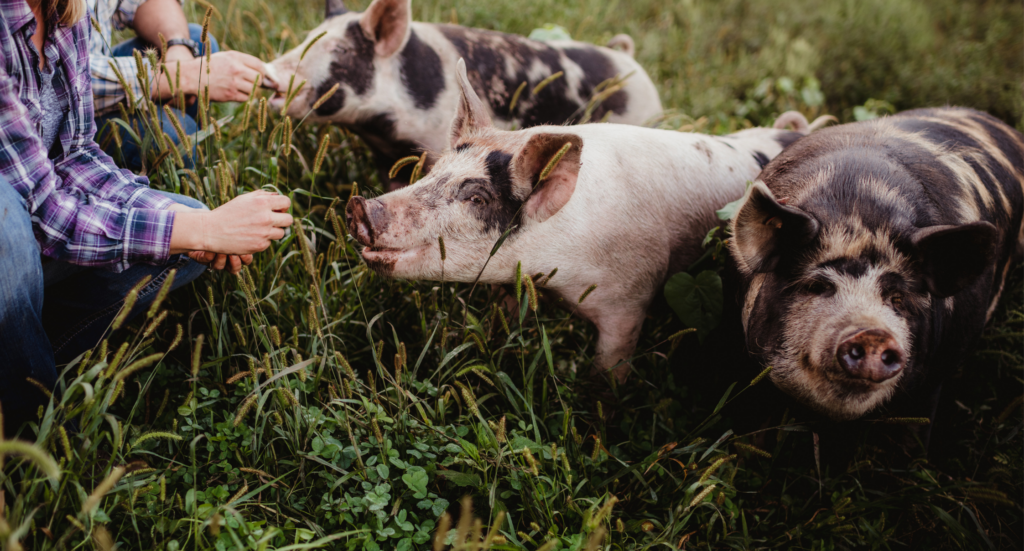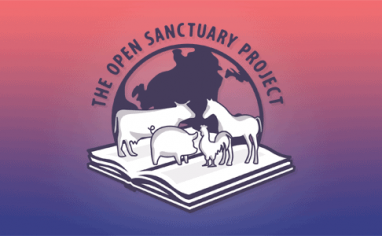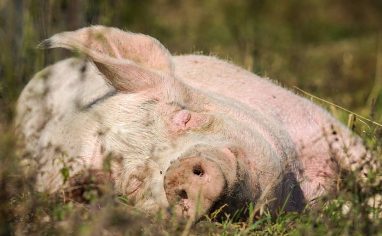
Written With Care
For sensitive readers, we want to note that while this resource explores the role sanctuaries can play in providing a home and caring for farmed animalA species or specific breed of animal that is raised by humans for the use of their bodies or what comes from their bodies. species exploited in research, it will not detail the kind of experiments these animals undergo.
Generally speaking, most residents at farmed animal sanctuariesAnimal sanctuaries that primarily care for rescued animals that were farmed by humans. have been exploited through agricultural practices. However, many farmed animal species are also used in laboratory research. In recent years, some private and governmental agencies have promoted the adoption of certain animals once used in experiments at research facilities. More than this, some have provided guidelines and made recommendations regarding adoption policies at research facilities. More and more, animal rescuesOrganizations that help secure animals from dangerous or unacceptable situations. As organizations, rescues may or may not have dedicated permanent infrastructure for housing animals. and sanctuaries have been made aware of this, in some cases, by the researchers themselves.
This mini-resource briefly discusses animal adoption policies at research facilities and how your sanctuary might assist in providing a home or help other sanctuaries and rescue organizations provide individuals with the chance to live a life free of exploitationExploitation is characterized by the abuse of a position of physical, psychological, emotional, social, or economic vulnerability to obtain agreement from someone (e.g., humans and nonhuman animals) or something (e.g, land and water) that is unable to reasonably refuse an offer or demand. It is also characterized by excessive self gain at the expense of something or someone else’s labor, well-being, and/or existence.. Let’s jump in!
Check In With An Attorney On Relevant Legal Considerations In Your Jurisdiction!
Some states have specific statutes that create legal frameworks for the adoption of animals formerly used in laboratories. There are also policies within certain federal administrative agencies in the United States that contemplate the adoption of such animals. On an even more local level, zoning regulations can impact species, types, and numbers of animals you can care for at your sanctuary. It is crucial that you consult with a qualified attorney in your jurisdiction to find out what laws apply when it comes to the adoption of such animals in your area, and to make sure that you are following all applicable requirements.
Nonhuman Animals In Research
Every year millions of nonhuman animals are used in scientific research. While mice and rats make up a large number of those used in experiments, many other species are also exploited, including a number of traditionally farmed animal species. Horses, alpacas, pigs, goats, rabbitsUnless explicitly mentioned, we are referring to domesticated rabbit breeds, not wild rabbits, who may have unique needs not covered by this resource., cowsWhile "cows" can be defined to refer exclusively to female cattle, at The Open Sanctuary Project we refer to domesticated cattle of all ages and sexes as "cows.", chickens, turkeysUnless explicitly mentioned, we are referring to domesticated turkey breeds, not wild turkeys, who may have unique needs not covered by this resource., ducksUnless explicitly mentioned, we are referring to domesticated duck breeds, not wild ducks, who may have unique needs not covered by this resource., fishes, and others are all used in research. Depending on the species, many of these studies are outside of veterinary or agricultural sciences and focus on human medical research or even nonmedical genetic engineering research. Animals are bred for use in experiments and it isn’t uncommon for some individuals to be euthanized as “excess” when they are not needed for a study. Regardless, all individuals deserve sanctuary. Some rescue organizations and animal sanctuaries, farmed animal sanctuaries included, have taken in animals from research laboratories. In some of these cases, researchers contacted rescues and sanctuaries to place animals. So how can your sanctuary get involved? Let’s take a look at governmental oversight and institutional guidelines and policies regarding the adoption of animals at research facilities.
Government Oversight And Institutional Guidelines
While there are no federal laws governing research facilities regarding the adoption of animals used in research, in the United States there are federal agencies such as the National Institute For Health and non-governmental agencies such as the American Veterinary Medicine Association that have created administrative guidance promoting the adoption of some animals used in research. This guidance provides suggested guidelines and recommendations to research facilities on adoption policies. Additionally, multiple states have enacted statutes allowing for the adoption of certain laboratory animals from publicly funded higher education institutes if they meet health and safety protocols. A number of universities already had adoption policies even before such government oversight. The Animal Legal and Historical Center at the University Of Michigan offers an interactive map noting the states that have Beagle Freedom Laws.
“These laws mandate that retired research dogs be released for adoption when they are no longer needed for research purposes. Typically, the laws facilitate relationships between research facilities and non-profit animal rescues or other animal adoption organizations to allow those organizations to offer retired dogs to members of the public. Iowa became the most recent state to enact such a law.”
As mentioned above, before creating a program to intake former laboratory animals, you will need to learn about the legalities of caring for individuals freed from research facilities in your country, and in your specific legal jurisdiction. Again, as always, when it comes to legal issues we recommend that you consult with a knowledgeable attorney in your jurisdiction to get clarity. Legalities may also vary depending on the species, the nature of research, local zoning laws, and how and where they will be transported. Before you reach out to any research facilities it is important to understand the legalities in your country, state, and local community. It is important to understand that labs cannot legally release some individuals used in experiments that may risk public health by either potentially contributing to the spread of zoonotic disease or creating other biosecurity risks.
How You Can Get Involved
Once you have determined the legality of taking in former laboratory animals in your jurisdiction, you can start to build a relationship with institutions of learning and research centers in your area. If a researcher reaches out, remember while you may have differing opinions, you share a common goal – to find sanctuary for someone. Reach out to other sanctuaries and established rescue organizations that have rescued animals from a laboratory and see if more homes are needed and how they communicate with researchers. Your tone and choice of wording can work for you or against you. Putting someone in a situation where they feel they have to defend themselves takes energy and attention away from rescuing someone. Once you’re clear on the legalities involved, action steps in starting a program might look like the following:
- Do a Google search to discover other sanctuaries and organizations that have rescued individuals from research settings. Contact them to see if they can share how they took in residents from research facilities.
- Search for articles on research and teaching facilities open to adoption and read about their stories.
- Search out and create a list of research and teaching facilities in your state and region.
- Prepare a thoughtfully and kindly written introduction to an appropriate contact at the facility, letting them know who you are, what your sanctuary provides, and how you are reaching out to them as a resource in the event they ever have the opportunity to adopt out animals from the facility.
- Keep it professional and warm. This simple step may result in an opportunity to help individuals who otherwise may not have the chance. Hesitancy on the part of researching institutions part is not to be unexpected. They are possibly imagining the facility being in the news shown in a negative light or that you may be hostile and judgemental.
Before You Take That Step
Doing a thoughtful assessment of your sanctuary and its capacity prior to any intakes is an important part of maintaining sanctuary sustainability. Know what species you have the space, knowledge, skills, and budget to care for at your sanctuary. Discuss this with your care staff and board. You don’t want to be unprepared and you don’t want to place an undue burden on care staff who may already be stretched thin. Unsure whether you should take in new residents? Check out our resource “25 Questions To Help Guide Responsible Intake Decisions At Your Animal Sanctuary”
- Learn who you are legally allowed to care for at your sanctuary. The local zoning laws may vary depending on the species, the nature of the research, the country, and local zoning laws, among other factors. Before you reach out to any research facilities, learn the legalities in your country, state, and local community.
- As mentioned above, discuss your sanctuary capacity and the practicalities of welcoming more residents with your board and care staff. Do you have the budget? Does care staff have the bandwidth?
- Consider what you will do if they respond positively but tell you they are looking to find sanctuary for a species you don’t currently have in residence at your sanctuary or had planned to have as sanctuary residents. Is this within the scope of your missionThe stated goals and activities of an organization. An animal sanctuary’s mission is commonly focused on objectives such as animal rescue and public advocacy.? Check out our resource “Understanding Mission And Vision Statements For Your Animal Organization”
Navigating Conflict With Care
It is an understatement to say it is challenging to build a positive relationship with another whose core beliefs differ significantly from yours. However, it is important not to assume everyone you connect with is uncaring in this story. People have different motivations and experiences that lead them to where they are and the ethical decisions they make when it comes to laboratory animal adoption. They may have their own ethical, or possibly health-related concerns. Sometimes students request animals used in their class study be adopted. In at least one case, it was the researcher who insisted the rats in the studies be adopted. Being professional and kind can help open up more doors in the future and plant more seeds that may change how someone sees the issue. Attacking someone through harsh language and judgmental statements is more likely to drive someone away and shut down lines of communication.
Conflict can be difficult to navigate, so before reaching out to someone at a research facility, we recommend reading both of these resources:
Conflict Support For Your Animal Organization: Part 2 Building Transformative Relationships: Tools for Challenging Dominant Culture in Everyday Interactions. We recommend everyone read these resources!
There Are Many Ways To Help!
If you’d like to help laboratory animals in need of homes, but know that your sanctuary cannot provide long-term care, there are other ways to assist. Working with other sanctuaries, you may be able to offer temporary shelter and care, help with transportation from the facility to another sanctuary, or even bring awareness by sharing posts of their stories on social media platforms.
Regardless of whether or not you can provide direct care, we hope this resource has given you ideas of how you can be involved in other capacities. If you are seeking another way to help, share this resource! More individuals may find homes by spreading the word, especially in the sanctuary world. If you have taken in residents from research facilities, we would love to hear from you and learn more!
SOURCE:
When A Farm Is A Lab | AV Magazine
Birds In Research | AV Magazine Page 4
A Call to Action for the Forgotten Animals of Science | Kindness Ranch Quarterly
5 Awesome Rescue Groups Helping Former Lab Animals | One Green Planet
Chester’s Journey From Farm to Laboratory to Sanctuary | All Creatures
Sanctuary For Lab Animals In Italy | Italy Magazine
Policy On Animal Adoption | Queens University (Non-Compassionate Source)
Research Animals Rehoming Guidelines | Department Of Primary Industries (Non-Compassionate Source)
Adoption of Laboratory Animals after Research | National Institute Of Health (Non-Compassionate Source)
Adoption Of Research And Teaching Animals | American Veterinary Medicine Association (Non-Compassionate Source)
The F.D.A. Will Now Allow Lab Animals to Be Adopted | Smithsonian Magazine (Non-Compassionate Source)
A Semi-Structured Questionnaire Survey Of Laboratory Animal Rehoming Practice Across 41 UK Animal Research Facilities | Plos One (Non-Compassionate Source)
Non-Compassionate Source?
If a source includes the (Non-Compassionate Source) tag, it means that we do not endorse that particular source’s views about animals, even if some of their insights are valuable from a care perspective. See a more detailed explanation here.








